england
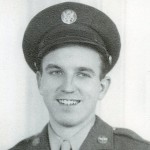 In 1990, when the remake of the movie, Memphis Belle came out, I watched it with intrigue, knowing that my Dad, Allen Spencer had been a top turret gunner and flight engineer on a B-17G Bomber in the 8th Air Force stationed in Great Ashfield, Suffolk, England. The Memphis Belle, a Boeing-built B-17F-10-BO, USAAC Serial No. 41-24485, was added to the USAAF inventory on July 15, 1942, and delivered in September 1942 to the 91st Bombardment Group at Dow Field, Bangor, Maine. She deployed to Prestwick, Scotland, on September 30, 1942, moving to a temporary base at RAF Kimbolton on October 1, 1942, and then finally to her permanent base at Bassingbourn, England, on October 14, 1942. Each side of the fuselage bore the unit identification markings of the 324th Bomb Squadron (Heavy). My dad was a part of the 385th Bomb Squadron (Heavy). Dad didn’t arrive in England until early April of 1944. His letter from April 14, 1944 tells his family that he had arrived and couldn’t tell them where he was for security reasons, except to say that he was somewhere in England.
In 1990, when the remake of the movie, Memphis Belle came out, I watched it with intrigue, knowing that my Dad, Allen Spencer had been a top turret gunner and flight engineer on a B-17G Bomber in the 8th Air Force stationed in Great Ashfield, Suffolk, England. The Memphis Belle, a Boeing-built B-17F-10-BO, USAAC Serial No. 41-24485, was added to the USAAF inventory on July 15, 1942, and delivered in September 1942 to the 91st Bombardment Group at Dow Field, Bangor, Maine. She deployed to Prestwick, Scotland, on September 30, 1942, moving to a temporary base at RAF Kimbolton on October 1, 1942, and then finally to her permanent base at Bassingbourn, England, on October 14, 1942. Each side of the fuselage bore the unit identification markings of the 324th Bomb Squadron (Heavy). My dad was a part of the 385th Bomb Squadron (Heavy). Dad didn’t arrive in England until early April of 1944. His letter from April 14, 1944 tells his family that he had arrived and couldn’t tell them where he was for security reasons, except to say that he was somewhere in England.
At the time I watched the remake of the original 1943 documentary film put out by the War Department, I assumed that while the movie said it was based on a true story, there was probably a lot of Hollywood hype to 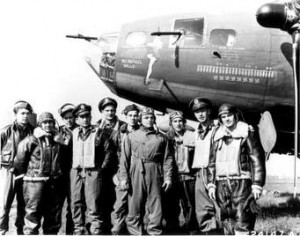 the movie. So, when I read my dad’s letter to his mother, my grandmother, Anna Schumacher Spencer, I was surprised that my dad mentioned it and said she should go see it. From my experience with the movie, I don’t think it would be a film I’d want to watch while my child was still on active duty and fighting from one of those planes. Both the original version and the remake were real enough to either show or tell of events involving the B-17 Bombers in combat situations, and the inevitable shooting down of the planes by the enemy.
the movie. So, when I read my dad’s letter to his mother, my grandmother, Anna Schumacher Spencer, I was surprised that my dad mentioned it and said she should go see it. From my experience with the movie, I don’t think it would be a film I’d want to watch while my child was still on active duty and fighting from one of those planes. Both the original version and the remake were real enough to either show or tell of events involving the B-17 Bombers in combat situations, and the inevitable shooting down of the planes by the enemy.
Of course, the point was to let people know that The Memphis Belle, a B-17 Bomber had become the first plane to accomplish 25 missions without being shot down. It was designed to be a celebration of that accomplishment. And so it was, but it also proved the stark reality that many other B-17 Bombers had been shot down, and in all reality would continue to be shot down. While the accomplishment of The Memphis Belle is nothing to take lightly, I think it would still be hard to think about all those men lost or imprisoned during that war…especially if I was the mother of an airman. In some ways, it surprised me that my dad would even ask his mom to so see the movie. He was always so protective of her. I suppose that in time, you get used to the events of war, especially when you are in the thick of it day after day, and maybe he thought it would give her hope too.

Nevertheless, it seemed rather strange to me that Dad had talked of this movie with his mother. I know that the Memphis Belle was a star, just because they had made it through without being shot down. They were the first, and to those at home trying to support the war effort, that was a moral booster. That made it important to do the movie and to have the Memphis Belle and her crew do tours back in the states. People needed to see the success of the air war. They needed hope that their loved ones would return. I suppose that was what my dad was thinking when he told his mother that she should go see the movie. I don’t know for sure if she did or didn’t, but in the end my dad came home, and that is all that mattered to my grandmother and to me.
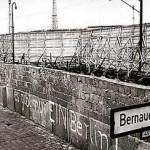
 On August 13, 1961, in the hours just after midnight, the East German soldiers began laying down barbed wire and bricks as a barrier between Soviet-controlled East Berlin and the democratic western section of the city. It was a day that would change life in Berlin for the next twenty eight years. In the days that followed, a wall was built to permanently close off access to the west. The citizens of East Berlin became prisoners in their own homes and city, in a prison that was built around them. The road between East and West Berlin had become a one way street. If you wanted in, you couldn’t come back out. Families were separated from each other, and those in the West had to make the choice to go be with family in East Berlin…and captivity, or not. The wall became the symbol of the Cold War. It was a literal Iron Curtain, dividing Europe.
On August 13, 1961, in the hours just after midnight, the East German soldiers began laying down barbed wire and bricks as a barrier between Soviet-controlled East Berlin and the democratic western section of the city. It was a day that would change life in Berlin for the next twenty eight years. In the days that followed, a wall was built to permanently close off access to the west. The citizens of East Berlin became prisoners in their own homes and city, in a prison that was built around them. The road between East and West Berlin had become a one way street. If you wanted in, you couldn’t come back out. Families were separated from each other, and those in the West had to make the choice to go be with family in East Berlin…and captivity, or not. The wall became the symbol of the Cold War. It was a literal Iron Curtain, dividing Europe.
When World War II ended in 1945, Germany was divided into four Allied occupation zones. Berlin, the German capital, was likewise divided into occupation sectors, even though it was located deep within the Soviet occupation zone. The future of Germany was a source of contention. Disagreements brought tensions which grew when the United States, Britain, and France moved in 1948 to unite their occupation zones into a single autonomous entity known as the Federal Republic of Germany or West Germany. In response, the Soviet Union launched a land blockage of West Berlin in an effort to force the West to abandon the city. The United States and Britain responded with a massive airlift of food and supplies to West Berlin, and in May of 1949, the Soviet Union ended the blockade in defeat.
That didn’t remove the tensions that plagued the area, however. By 1961 the Cold War tensions were running high again. The East German people became very dissatisfied with life under the communist system. West Berlin was a gateway to the West and Democracy. Between 1949 and 1961, about 2.5 million East Germans fled East Berlin to West Germany. By August of 1961, East Germans were crossing into West Germany at a rate of 2,000 people per day. Many of the refugees were skilled laborers, professionals, and intellectuals, and their loss was having a devastating effect on the East German economy. The Soviets had to figure out a way to stop the exodus, and its devastating effect on the economy. Soviet leader Nikita Khruschev made the decision to close off access from East Berlin to West Berlin.
Then came the night of August 13, 1961. The citizens of East Berlin could no longer freely pass into West Berlin. The West was taken by surprise, and threatened a trade embargo against East Germany as a retaliatory measure. The Soviets responded that such a measure would bring new blockades. The West did nothing, and the East German authorities grew more and more bold. They began closing of more and more checkpoints between East and West Berlin. On August 15, they began replacing barbed wire with concrete. The wall was supposedly designed protect their citizens from the influence of decadent capitalist culture. In realty, it protected the East German authorities from scrutiny as they did what they wanted with out retaliation.
Once it was up, the only way for East Berliners to escape the oppression of their government was to take their chances to get across in whatever way they could dream up. People attempted escape by train, tight rope, zip lines, hot air balloons, through old tunnels, impersonating soldiers, a stolen tank, and swimming. Many of these attempts ended in death for the person attempting escape. It didn’t stop them. They were so determined to live freely. About 5,000 East Germans managed to escape across the Berlin Wall to the West, but the frequency of successful escapes dwindled as the wall was increasingly fortified. Thousands of East Germans were captured during attempted crossings and 191 were killed.
On June 12, 1987 President Reagan made his great “tear down this wall” speech, but the wall remained until 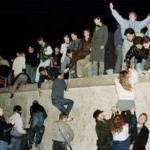
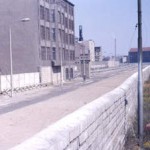 1989, when the democratization movement began sweeping across Eastern Europe. On November 9, 1989 travel restrictions were eased. Jubilant Berliners climbed on top of the Berlin Wall, painted graffiti on it, and removed fragments as souvenirs. The next day, East German troops began dismantling the wall. In 1990, East and West Germany were formally reunited. For those in the free world, it would be almost impossible to completely understand just what Communism was like, but those who lived it, would never forget it, if they even lived through it, which many didn’t.
1989, when the democratization movement began sweeping across Eastern Europe. On November 9, 1989 travel restrictions were eased. Jubilant Berliners climbed on top of the Berlin Wall, painted graffiti on it, and removed fragments as souvenirs. The next day, East German troops began dismantling the wall. In 1990, East and West Germany were formally reunited. For those in the free world, it would be almost impossible to completely understand just what Communism was like, but those who lived it, would never forget it, if they even lived through it, which many didn’t.
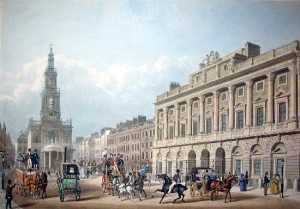 Anyone who has ever tried to trace their family history knows just how difficult it can be to find the records sometimes. Early families kept their records mostly in the family Bible, or some other type of record keeping book, and if the records weren’t kept where they were safe, or where the next generation knew to look for them, they were often lost. It seems that some nations were more ahead of the pack when it came to registering the people…where it was for a good purpose or not. Later it was only churches that kept records of these things.
Anyone who has ever tried to trace their family history knows just how difficult it can be to find the records sometimes. Early families kept their records mostly in the family Bible, or some other type of record keeping book, and if the records weren’t kept where they were safe, or where the next generation knew to look for them, they were often lost. It seems that some nations were more ahead of the pack when it came to registering the people…where it was for a good purpose or not. Later it was only churches that kept records of these things.
The Bible tells us in Luke 2:1-5, “And it came to pass in those days that a decree went out from Caesar Augustus that all the world should be registered. This census first took place while Quirinius was governing Syria. So all went to be registered, everyone to his own city. Joseph also went up from Galilee, out of the city of Nazareth, into Judea, to the city of David, which is called Bethlehem, because he was of the house and lineage of David, to be registered with Mary, his betrothed wife, who was with child.” In many way, I suppose it was from this point on that the Romans and Jews began to keep such clear records, although, according to the Bible and the lineage of Jesus told there, the Jews had kept very clear records before that. It was clear record keeping of this type that made it possible for families to know their heritage.
As I have searched for my own ancestors, I have found that in more modern times, such as the 1000 to 1700s, the record keeping was not so good. I don’t know if people were just more lax about it, or if there seemed to be no good place to store these things. I could also be that in cases where good records were kept, fire, flood, or some other natural disaster destroyed them later on. I find that to be such a sad state of affairs, because it can put up a wall between the genealogical researcher and the valuable information they are searching for.
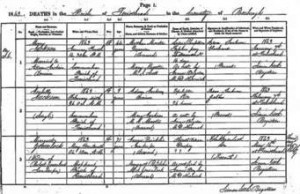
I guess I’m not the only person to ever feel that way, because on this day, July 1, 1837, England and Wales established the Civil Registration system to record births, marriages, and deaths. It is that same system that is used in Ancestry.com to provide valuable records used by genealogical researchers to this day. Of course, in the early days, the records were stored in volume after volume in some dusty corner of a courthouse or something. It was very hard to research family through that avenue, but with the invention of the internet, and the transfer of those records to it, the civil registration of births, marriages, and deaths has opened up many new doors in genealogical research.
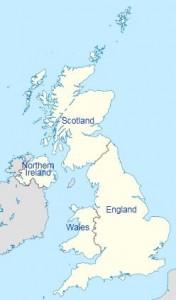 Many people may not be aware that in the United Kingdom of Great Britain, there is almost a constant state of confusion over just exactly who they are. They are considered Great Britain or the United Kingdom, but the United Kingdom takes in the countries of England, Scotland, Wales and Northern Ireland. It was on this day May 1, 1707 that England and Scotland joined together to become the United Kingdom. I think the union must have been a bit surprising, given that the English and the Scots had long battled over one thing or another. Nevertheless, The Scots needed the economic support that England could offer, while for England the merger was political. The Scots would no longer have a Parliment, but they were given instead a proportion of the seats at Westminster.
Many people may not be aware that in the United Kingdom of Great Britain, there is almost a constant state of confusion over just exactly who they are. They are considered Great Britain or the United Kingdom, but the United Kingdom takes in the countries of England, Scotland, Wales and Northern Ireland. It was on this day May 1, 1707 that England and Scotland joined together to become the United Kingdom. I think the union must have been a bit surprising, given that the English and the Scots had long battled over one thing or another. Nevertheless, The Scots needed the economic support that England could offer, while for England the merger was political. The Scots would no longer have a Parliment, but they were given instead a proportion of the seats at Westminster.
The English tend to call Great Britain, England, with notorious disregard for the feelings of the Welsh, with whom they joined in 1536 and the Scots, with whom they joined in 1707. The Act of Union of 1707, states merely that England and Scotland shall ‘be united into one kingdom by the name of Great Britain’. Many people simply lumped them together as Britain, calling all of them the Brits, which technically isn’t so…and even the English didn’t like that name. The last official merger was with Northern Ireland in 1800, at which time the enlarged kingdom became the United Kingdom of Great Britain.
It’s hard for me to think about being a country that is part of a kingdom, and yet, I suppose that is exactly what we were when the United States of America was part of England. Although we may not have been considered a part of a kingdom exactly, we were under British rule until the Revolutionary War. I suppose that there could be a love/hate relationship among the countries of the United Kingdom to this day. I do think that the British Royals do like to go to the different countries that are a part of the United Kingdom, and maybe 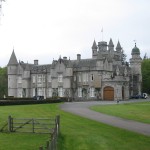
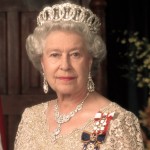 those countries like having them come for a visit now, but I have to wonder if that was always the case. Queen Elizabeth heads to her Scottish castle, Balmoral, at this time of the year, so she must love the whole Scottish countryside at least almost as much as she does England. For Queen Elizabeth, having a castle in Scotland is normal. I suppose that if you grew up being a part of a kingdom, it would be normal, and in all reality, while it wasn’t always a kingdom, it has been since 1536, so it might as well have been always…at least for the people who call the United Kingdom of Great Britain home.
those countries like having them come for a visit now, but I have to wonder if that was always the case. Queen Elizabeth heads to her Scottish castle, Balmoral, at this time of the year, so she must love the whole Scottish countryside at least almost as much as she does England. For Queen Elizabeth, having a castle in Scotland is normal. I suppose that if you grew up being a part of a kingdom, it would be normal, and in all reality, while it wasn’t always a kingdom, it has been since 1536, so it might as well have been always…at least for the people who call the United Kingdom of Great Britain home.
 The dukedom of Marlborough is one of the titles in the Peerage of England. The Peerage of England comprises all peerages created in the Kingdom of England before the Act of Union in 1707. In that year, the Peerages of England and Scotland were replaced by one Peerage of Great Britain. The peerage is a legal system of largely hereditary titles in the United Kingdom, which is constituted by the ranks of British nobility and is part of the British honors system. The dukedom of Marlborough was created by Queen Anne in 1702, for John Churchill, who was the 1st Duke of Marlborough.
The dukedom of Marlborough is one of the titles in the Peerage of England. The Peerage of England comprises all peerages created in the Kingdom of England before the Act of Union in 1707. In that year, the Peerages of England and Scotland were replaced by one Peerage of Great Britain. The peerage is a legal system of largely hereditary titles in the United Kingdom, which is constituted by the ranks of British nobility and is part of the British honors system. The dukedom of Marlborough was created by Queen Anne in 1702, for John Churchill, who was the 1st Duke of Marlborough.
I can’t say that I completely understand all there is to about the peerage of Great Britain, but in the peerage, a Duke is a higher rank than a Marquess, Earl, Viscount and Baron. Thus Prince William is the Duke of Cambridge, because as the prince, it would not be right for him to have a lower rank than other members of the peerage. Originally dukes were the rulers of the provinces of the Roman Empire. Now however, the title of duke has become in almost all cases a nominal rank, without possession of an actual principality. The province that a duke was titled over, is known as a duchy. As I said, in modern times dukes aren’t really over a duchy, with the exception of Lancaster and Cornwall, both of which do include land and ownership. Lancaster belongs to Queen Elizabeth II and Cornwall to Prince Charles. The title of duke cannot normally be handed down to female heirs, but the Dukedom of Marlborough is the exception to that rule. It is one of the few titles that allows females to inherit the title, and the only current dukedom to do so.
In the Spencer family, there have been a number of titles, but it wasn’t until Charles Spencer, 3rd Earl of Sunderland, widowed following the death of his first wife, Arabella, daughter of Henry Cavendish, 2nd Duke of  Newcastle, married Anne Churchill, that the Dukedom of Marlborough first came to the Spencers. With this dukedom, Charles Spencer was first introduced to politics, making this alliance between Sunderland and Marlborough a very important one for Charles and his descendants. From his marriage to Anne Churchill who would become the 2nd Duke of Marlborough, the Spencer family would retain the dukedom for all time. At the current time, the dukedom is at 12, with Charles James Spencer-Churchill, 12th Duke of Marlborough, born in 1955, as the current duke.
Newcastle, married Anne Churchill, that the Dukedom of Marlborough first came to the Spencers. With this dukedom, Charles Spencer was first introduced to politics, making this alliance between Sunderland and Marlborough a very important one for Charles and his descendants. From his marriage to Anne Churchill who would become the 2nd Duke of Marlborough, the Spencer family would retain the dukedom for all time. At the current time, the dukedom is at 12, with Charles James Spencer-Churchill, 12th Duke of Marlborough, born in 1955, as the current duke.
To date, I cannot say how many dukes and duchesses were or are Spencer descendants, for names change with marriages over the years. Nevertheless, the Spencers have played a great part in the peerage of Great Britain, and with Prince William and his descendants, beginning with Prince George, the Spencers will continue to have great influence in that nation for the rest of time.
 Living to be 95 years old is an amazing accomplishment, and one that few people are blessed enough to achieve. Today, that is the place where my husband, Bob’s great uncle, Frank Knox is. I think Frank was always my mother-in-law, Joann Schulenberg’s favorite uncle…doesn’t every girl have one or even two. When I found my mother-in-law’s childhood scrapbook among the photo albums and old pictures she had in a box in her closet, as we were preparing to sell their home to help pay for her care, after my father-in-law passed away, I noticed several pictures with her and her Uncle Frank, as well as pictures of him alone.
Living to be 95 years old is an amazing accomplishment, and one that few people are blessed enough to achieve. Today, that is the place where my husband, Bob’s great uncle, Frank Knox is. I think Frank was always my mother-in-law, Joann Schulenberg’s favorite uncle…doesn’t every girl have one or even two. When I found my mother-in-law’s childhood scrapbook among the photo albums and old pictures she had in a box in her closet, as we were preparing to sell their home to help pay for her care, after my father-in-law passed away, I noticed several pictures with her and her Uncle Frank, as well as pictures of him alone.
Frank was stationed in England during World War II, as was my dad. I’m not sure where in England, but it would have been interesting to see if they ever crossed paths. It’s possible that worry and the unknown were things that made my mother-in-law love 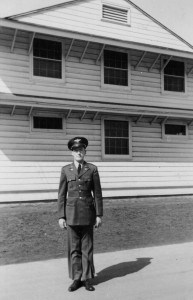 seeing her uncle, because even when kids are young, they are well able to understand the dangers that their loved ones are being placed in, and they worry that they will not make it home. There really is no definite skill that keeps a soldier alive in a war. Some just come home, and others don’t. That is probably the thing that makes the homecoming so very sweet.
seeing her uncle, because even when kids are young, they are well able to understand the dangers that their loved ones are being placed in, and they worry that they will not make it home. There really is no definite skill that keeps a soldier alive in a war. Some just come home, and others don’t. That is probably the thing that makes the homecoming so very sweet.
The first time I met Frank was the end of June, 1976, when they brought Frank’s parents, my mother-in-law’s grandparents for a visit. It was partly, I’m sure so that they could meet their two great great granddaughters, my girls, Corrie and Amy, but also to see the rest of the family. Living so far away, in Yakima, Washington, they didn’t get to see this part of the family very much, and Great Grandma and Grandpa were getting older. We did not know it then, but it would be the last time we saw Great Grandpa, since he would pass away the following August…just two months later. I think we all felt very grateful to Frank, his wife, Helen, and their youngest son, Richard 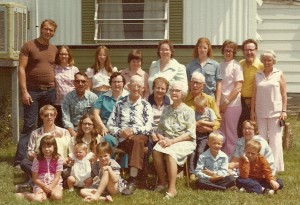 for bringing Great Grandma and Grandpa Knox to Casper for such a lovely visit.
for bringing Great Grandma and Grandpa Knox to Casper for such a lovely visit.
Frank is a very intelligent man, and while his mind may not be quite as sharp as it was in his youth, he still remembers all of us and his little niece, my mother-in-law, Joann Schulenberg. He always calls her on her birthday, and while she won’t have a phone this year, we will make sure that we get them on the phone for that very important call. And perhaps we can surprise him today with a phone call from her, because I think she probably did that too, before Alzheimer’s Disease stole the memory of the date from her. Today is Frank’s 95th birthday. Happy birthday Frank!! Have a great day!! We love you!!
 I’m sure that most of you have heard that funny song by Ray Stevens called, “I’m My Own Grandpa”, and while I’m not going to tell you that I’m my own grandma, I will tell you that my husband’s Grandma Hein is my 12th cousin twice removed. We always enjoyed both of his grandmothers, but we got to see so much less of Grandma Hein, that it was very special when we got to go see her. I only knew one of my grandmothers, and my she passed away when Bob and I had only been married eleven years. His Casper grandparents died in the 80’s too, as did his Grandpa Schulenberg in Montana. So, much of my adult life was spent having only Bob’s Montana grandparents, Grandma and Grandpa Hein, in my life. I loved spending time with them, and we made annual trips up to visit them. We wanted our girls to know them too, so the trips were a special family time for all of us.
I’m sure that most of you have heard that funny song by Ray Stevens called, “I’m My Own Grandpa”, and while I’m not going to tell you that I’m my own grandma, I will tell you that my husband’s Grandma Hein is my 12th cousin twice removed. We always enjoyed both of his grandmothers, but we got to see so much less of Grandma Hein, that it was very special when we got to go see her. I only knew one of my grandmothers, and my she passed away when Bob and I had only been married eleven years. His Casper grandparents died in the 80’s too, as did his Grandpa Schulenberg in Montana. So, much of my adult life was spent having only Bob’s Montana grandparents, Grandma and Grandpa Hein, in my life. I loved spending time with them, and we made annual trips up to visit them. We wanted our girls to know them too, so the trips were a special family time for all of us.
After so many years of knowing them, Grandma and Grandpa Hein became my own grandparents. Little did I know then, or at any time during her lifetime, that Grandma Hein was actually my 12th cousin twice removed. When I made that connection a short time ago, I was so surprised. I’ve known for some time now that Bob and I are cousins to varying degrees, but somehow, in my mind, that didn’t officially connect to the prior ancestors. I mean, I knew it, but they didn’t feel like cousins, for some reason. Then I started thinking about that with respect to Grandma Hein when I came across a relationship between her dad’s family and my dad’s family. Somehow, it was at this point that my mind completed wrapping itself around the idea that I was related to Grandma’s family, and it hit me that my grandma was my cousin.
I’m sure that should have hit me before too, but somehow, she was Bob’s grandma, and therefore, mine by marriage, which she technically still is, in addition to our cousinship. I really wish I had know that she was my cousin too, because I think we would have liked that relationship too. I’m sure we would have both been surprised, and we probably would have had a good laugh too. Nevertheless, I think that we both would have liked that fact as well. We were always good friends, so being cousins too, would have been fun.
The cousinship occurred before either of us were ever born, of course. Our common ancestor is John Collamore  who is my 11 great grandfather, and Grandma’s 13th great grandfather, was born in 1500 in England. The fact that we were cousins could not have been easily known at the time of my marriage to Bob. The internet didn’t exist then, and so people had to go to these places to study their lineage. Too much time and too great a cost usually stopped that unless you were very determined. Nevertheless, whether we knew it or not, we are cousins, and I’m sure we will enjoy that conversation when we see each other again in Heaven. Today would have been Grandma Hein’s 106th birthday…and, Groundhog Day, a fact that she liked. Happy birthday Cousin Grandma Hein!! And happy Groundhog Day too…not that it matters in Heaven!! We love and miss you very much!!
who is my 11 great grandfather, and Grandma’s 13th great grandfather, was born in 1500 in England. The fact that we were cousins could not have been easily known at the time of my marriage to Bob. The internet didn’t exist then, and so people had to go to these places to study their lineage. Too much time and too great a cost usually stopped that unless you were very determined. Nevertheless, whether we knew it or not, we are cousins, and I’m sure we will enjoy that conversation when we see each other again in Heaven. Today would have been Grandma Hein’s 106th birthday…and, Groundhog Day, a fact that she liked. Happy birthday Cousin Grandma Hein!! And happy Groundhog Day too…not that it matters in Heaven!! We love and miss you very much!!

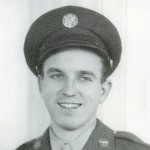 When I talked to my dad about his time at Great Ashfield in Suffolk, England, we talked about, among other things, the sign at the town entrance that still stands today, after all these years since the end of World War II. The picture of the B-17G Bomber flying low over the town is not something that would necessarily be well received these days, when people are so quick to complain about the planes when they live near an airport. I understand why people would not like planes flying low on takeoffs and landings these days, but the planes that fly over my house really don’t bother me at all. Nevertheless, my dad assured me that the people of Great Ashfield felt anything but irritation at the low flying planes that graced their skies during World War II.
When I talked to my dad about his time at Great Ashfield in Suffolk, England, we talked about, among other things, the sign at the town entrance that still stands today, after all these years since the end of World War II. The picture of the B-17G Bomber flying low over the town is not something that would necessarily be well received these days, when people are so quick to complain about the planes when they live near an airport. I understand why people would not like planes flying low on takeoffs and landings these days, but the planes that fly over my house really don’t bother me at all. Nevertheless, my dad assured me that the people of Great Ashfield felt anything but irritation at the low flying planes that graced their skies during World War II.
England was among the nations who had taken some serious hits by the Nazi war machine in the early days of World War II, prior to the entrance of the United States into the war. In fact, it was on this day, December 29, 1940 that London took a massive hit during a German raid. The German planes had been targeting London since August of 1940 as payback for the British attacks on Berlin. In September the Germans dropped 337 tons of bombs on docks, tenements, and the streets in one of London’s poorest districts. Then came December 29, 1940. The attack on that day produced widespread destruction of not just civilians, but also many of London’s cultural relics. The bombing was relentless and as a result, 15,000 separate fires were started. Historic buildings were severely damaged or destroyed. Among them, the Guildhall, which was an administrative center of the city 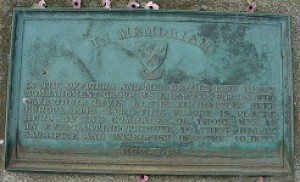 that dated back to 1673, but contained a 15th century vault. Eight Christopher Wren churches were also damaged or destroyed. St Paul’s Cathedral caught fire, but was saved by the firefighters who risked their own lives to save it. Westminster Abbey, Buckingham Palace and the Chamber of the House of Commons were also hit, but the damage to these was less severe. These attacks, that went on from September of 1940 through May of 1940, were known as the London Blitz, and they killed thousands of civilians.
that dated back to 1673, but contained a 15th century vault. Eight Christopher Wren churches were also damaged or destroyed. St Paul’s Cathedral caught fire, but was saved by the firefighters who risked their own lives to save it. Westminster Abbey, Buckingham Palace and the Chamber of the House of Commons were also hit, but the damage to these was less severe. These attacks, that went on from September of 1940 through May of 1940, were known as the London Blitz, and they killed thousands of civilians.
It wasn’t until Pearl Harbor was attacked on December 7, 1941, that the United States entered World War II, and soon after came the time that my dad spent at Great Ashfield beginning in early April of 1944 until he went home in October of 1945. While it may have seemed to many that we were somewhat late coming to the party, the war torn nations around the world were happy to see us arrive. It wasn’t that we were going to be the heroes riding in on the white horses, but we meant instant reinforcements to nations that needed assistance badly. The airmen were well received in the towns surrounding Great Ashfield, and the other air bases in England, but it was Great Ashfield that felt such gratitude that they went to the length of making and leaving to this day, the sign showing the B-17G Bomber flying low over the local church. There is also another memorial honoring the men of the 8th Air Force and the 385th Heavy Bombardment Group.
The reasons for the warm feelings toward the 8th Air Force and the 385th Heavy Bombardment Group are obvious. It was so much more than just the reinforcements the United States provided. While talking to my 
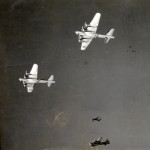 dad about this, he revealed that the main reason that they were so grateful is that the safest times for the area were when the B-17G Bombers were flying overhead. The German aircraft would become really scarce when the Bombers were around, because they didn’t want to be shot down either. The constant activity surrounding the air field made it almost impossible for the Germans to attack the area. Bombings are horrible, and take a huge toll on the civilians, as well as buildings. I suppose I would be eternally grateful for those planes, those men, and the United States 8th Air Force too. It gave peace of mind.
dad about this, he revealed that the main reason that they were so grateful is that the safest times for the area were when the B-17G Bombers were flying overhead. The German aircraft would become really scarce when the Bombers were around, because they didn’t want to be shot down either. The constant activity surrounding the air field made it almost impossible for the Germans to attack the area. Bombings are horrible, and take a huge toll on the civilians, as well as buildings. I suppose I would be eternally grateful for those planes, those men, and the United States 8th Air Force too. It gave peace of mind.
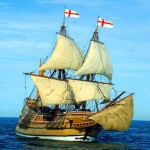 Thanksgiving Day is behind us for this year, of course, but today is a day that ties into Thanksgiving in a big way. On September 16, 1620, the Mayflower left Plymouth, England on its way to the New World. I can’t begin to imagine how so many of our ancestors must have felt at that time. It was going to be a long voyage, and some of them might not make it to the end of the trip, but going was worth the risk. There were 102 passengers on the 90 foot ship. The ship was bound for Virginia, where the colonists half of whom were religious dissenters and half of whom were entrepreneurs, and all of whom had been authorized to settle in the New World by the British crown. The trip was difficult, with rough seas and storms that blew the ship 500 miles off course. When they landed, it was in Massachusetts and not Virginia that the colonists found themselves, and I guess they were not bound by the exact location, because no one was there to tell them that they had to move. So they settled there.
Thanksgiving Day is behind us for this year, of course, but today is a day that ties into Thanksgiving in a big way. On September 16, 1620, the Mayflower left Plymouth, England on its way to the New World. I can’t begin to imagine how so many of our ancestors must have felt at that time. It was going to be a long voyage, and some of them might not make it to the end of the trip, but going was worth the risk. There were 102 passengers on the 90 foot ship. The ship was bound for Virginia, where the colonists half of whom were religious dissenters and half of whom were entrepreneurs, and all of whom had been authorized to settle in the New World by the British crown. The trip was difficult, with rough seas and storms that blew the ship 500 miles off course. When they landed, it was in Massachusetts and not Virginia that the colonists found themselves, and I guess they were not bound by the exact location, because no one was there to tell them that they had to move. So they settled there.
I did not recognize anyone on the passenger list that I specifically knew to be related to me, but there were numerous sir names that I have seen in my own family history. In researching the genealogy of the people from the Mayflower however, I find that we are related to some of them because, some of the people that we know that we are related to are related to some of them. An expedition of men was sent out to scout the land, and the ship remained anchored at the tip of Cape Cod in what is now Provincetown harbor in present day Provincetown, Massachusetts. While the men were out scouting for a suitable place to build a town, Susanna White, a passenger on the ship, gave birth to her second child, a son named Peregrine. He was the first English child born in New England.
The expedition found a suitable place to settle, with cleared fields and plentiful water. They returned to the ship and the ship was moved to what is now Plymouth Harbor, arriving on December 21st. Two days later, on December 23, 1620, construction began on the settlement that was to be named Plymouth…this day 394 years ago. The first year was really difficult, with half of the people dying of disease. It was a difficult time for the colonists. It wasn’t until 1621 that the health of the people improved…as did the economic condition, with a great harvest.
To celebrate, the governor, William Bradford invited neighboring Indians to Plymouth to celebrate the bounty of the year’s harvest, in what would become the first Thanksgiving Day celebration. The people secured peace treaties with the Indians, and soon more people were attracted to the settlement of Plymouth. By the 1640s the population was over 3,000, but was nevertheless, overshadowed by the larger population of the  Massachusetts Bay Colony that was started by Puritans in 1629.
Massachusetts Bay Colony that was started by Puritans in 1629.
Nevertheless, it would be the Plymouth colony who would have the honor of hosting the first Thanksgiving, and the honor of being know as the first Pilgrims. The name pilgrim did not come into being until the early 19th century and it was from a manuscript written by Govern Bradford in which he spoke of the “saints” who traveled to the New World as “pilgrimes” in 1620. Orator Daniel Webster spoke of the “Pilgrim Fathers” at a bicentennial celebration of Plymouths founding. The name pilgrim stuck and they have been know as such in history ever since. So, while Thanksgiving is past, believe it or not, its beginning actually happened on December 23, 1620, almost a year before the actual event took place.
 The Noyes side of Bob’s family was a family of prominence. The American side of the family begins with the Reverend William Noyes who was born in England in 1568. While William remained in England all his life, two of his children and a distant cousin left England and immigrated to America, settling in the Massachusetts area. The occupations included ministers of the Gospel, doctors, and commissioned army officers. One interesting fact is that in nearly every generation, there were two siblings who married siblings from another family. I have seen this is many families, including my own, and it makes me wonder if part of the reason is that there were fewer people around with children of suitable age to marry the children of a family. This might have been the case, especially when families began to move out west. In the history of the Noyes family that points out these siblings marrying siblings of another family, I find that Dr James III married Ann Sanford, who was the daughter of Governor Peleg and Mary Sanford, and his brother, Colonel Thomas Noyes married Ann’s sister, Elizabeth Sanford. While this is a bit unusual, it does happen, and there is nothing wrong with it. The fact that it happened about once a generation is a bit more unusual, but I guess it could be that these siblings had similar taste in mates.
The Noyes side of Bob’s family was a family of prominence. The American side of the family begins with the Reverend William Noyes who was born in England in 1568. While William remained in England all his life, two of his children and a distant cousin left England and immigrated to America, settling in the Massachusetts area. The occupations included ministers of the Gospel, doctors, and commissioned army officers. One interesting fact is that in nearly every generation, there were two siblings who married siblings from another family. I have seen this is many families, including my own, and it makes me wonder if part of the reason is that there were fewer people around with children of suitable age to marry the children of a family. This might have been the case, especially when families began to move out west. In the history of the Noyes family that points out these siblings marrying siblings of another family, I find that Dr James III married Ann Sanford, who was the daughter of Governor Peleg and Mary Sanford, and his brother, Colonel Thomas Noyes married Ann’s sister, Elizabeth Sanford. While this is a bit unusual, it does happen, and there is nothing wrong with it. The fact that it happened about once a generation is a bit more unusual, but I guess it could be that these siblings had similar taste in mates.
One of the main reasons that some of the Noyes men moved to American is the same as the reason that many of the first settlers came to America…religious differences with the Church of England. The United States has always been a country that prides itself of personal and religious freedoms. James, who is my husband, Bob’s 7th great grandfather, and who was born in England in 1608, married Sarah Brown, and they immigrated to America, and shortly thereafter, he became one of the founders of Newbury, Massachusetts, where he and his wife settled. He was a minister of the Gospel there for twenty years, and was very well liked in the area. His memory is still precious there to this day.
The Reverend James II, who is my husband, Bob’s 6th great grandfather, and who is the second son of James I and Sarah, followed in the footsteps of his dad, as a minister of the Gospel. His biggest claim to fame is that he bore an active part in the founding of Yale College, and his name was the first of “Ten of the principal ministers in the colony, nominated and agreed upon by general consent both of the ministers and people to stand as Trustees or Undertakers, to found, erect and govern a college.” He was selected to be one of the first trustees and founders of Yale. By this time he was an old man and lived in a remote part of the county, but his influence was considered essential to the undertaking. During his ministry he is noted to have baptized one thousand one hundred and seventy-six persons.
Deacon Noyes, who is the fifth son of Reverend James Noyes II, and Bob’s 5th great grandfather, married Dorothy Stanton, which is part of the  reason I have to wonder in there is a connection between my dad’s half brother’s mother, Edna Stanton, and Bob’s family through Dorothy Stanton. My grandfather, Allen Spencer, and Edna Stanton Spencer had a daughter, who they named Dorothy, and that along with the name Stanton, gives one reason to wonder. I am encouraged a little bit in my search, in that the Noyes family kept good family records. I hope this will be a useful when it comes to a possible connection between the Stantons of the Noyes family, and the Stanton of the Spencer family. Whatever happens, I find that the Noyes family were honorable people of distinction. They were active in their communities, loved and respected, making them a great American family.
reason I have to wonder in there is a connection between my dad’s half brother’s mother, Edna Stanton, and Bob’s family through Dorothy Stanton. My grandfather, Allen Spencer, and Edna Stanton Spencer had a daughter, who they named Dorothy, and that along with the name Stanton, gives one reason to wonder. I am encouraged a little bit in my search, in that the Noyes family kept good family records. I hope this will be a useful when it comes to a possible connection between the Stantons of the Noyes family, and the Stanton of the Spencer family. Whatever happens, I find that the Noyes family were honorable people of distinction. They were active in their communities, loved and respected, making them a great American family.

